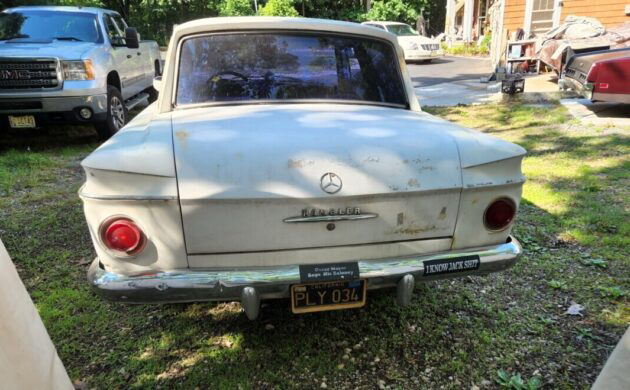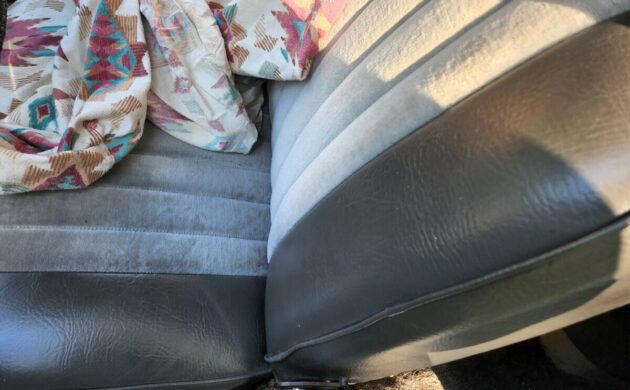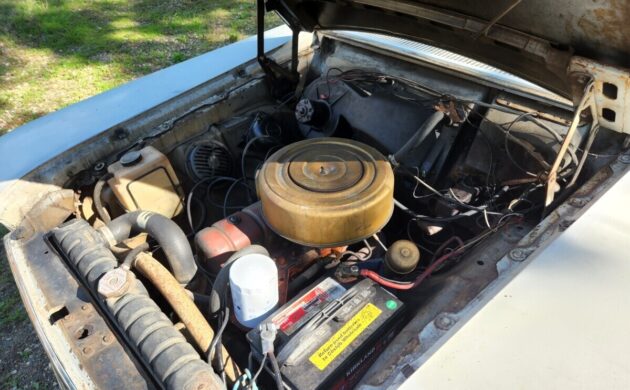Nash-Kelvinator Corp. and Hudson Motor Car Co. merged in 1954 to form American Motors. Soon after, they began to consider new product offerings, and the Rambler American was born in 1958. It began as an updated and modernized version of the 1950 Nash Rambler. The car was a success and would stick around through 1969. This second-generation American from 1962 is a two-owner car that’s said to be in good running condition. From Hazlet, New Jersey, the little compact is available here on Barn Finds Classifieds for $6,000.
The 1961-63 Americans looked quite different than their predecessors but were mechanically the same as the 1960 editions. They would be leaner in width and length but have greater cargo-carrying capacity. Popular Mechanics commented that “seldom has a car been completely restyled as the 1961 Rambler American and yet retain the same engine, driveline, suspension on the same unit-body”. All outside sheet metal was changed, but the side window frames were the same as before, only the rear glass was changed to fit the new roofline. Changes to the cars would be minimal for 1962.
This ‘62 American had only a single owner before the seller. At 65,000 miles, it looks to be a nice automobile though not perfect. The paint, whether original or not, has held up though it’s lost some of its luster over the years. The tinted windows no doubt help to keep the interior cool, though they were added before the car changed hands. What we can see of the interior looks good, but the seats may have been redone in newer materials.
Under the hood should be AMC’s 196 cubic inch inline-six which was in use throughout the 1960s, paired with a 3-speed manual transmission. AMC assembled about 47,000 of the American 2-door sedans in 1962, depending on the trim level offered. Some recent work was done on the car, including some carburetor tinkering, lower ball joints, and one new tire. A few extra parts will follow the Rambler to its next home. The American would be the last AMC product to carry the Rambler name, seeing varied production of 4.2 million cars over the duration.






Love the Mercedes-Benz badge on the trunk! I don’t think it’s fooling anyone though. (Some of the bigger Ramblers from the late 1950s did resemble Mercedes of that time if you squint a bit.)
No ball joints on these, the front suspension has trunnions on both top and bottom control arms. Photo of the dashboard and shift quadrant clearly shows that it has an automatic transmission, a Borg-Warner 3-speed unit. “Drive 1” starts out in 1st gear “Drive 2” in second gear.
https://barnfinds.com/wp-content/uploads/2022/06/20220612_163332-rotated.jpg
This American has the upgraded OHV engine which should make it more spritely than the standard L-head mill.
I’ve owned a couple of these cars over the years. They drive like a car designed in the 1940s – because they were.
Fortunately or unfortunately our roads were designed in the 20s…
Definitely reupholstered:
http://www.oldcarbrochures.com/static/NA/AMC/1962_AMC/1962_Rambler_Brochure/1962%20Rambler-04-05.html
Velour didn’t become common till the late sixties.
Great piece.
Interesting story how Nash & Hudson merged forming AMC and AMC brought the early 1950’s “bathtub” Nash Rambler back into production with little change other than opening up the front wheel wells. Then they reskinned the unibody (this car) to try to make it look more like a 1960’s car going from bathtub to 1960’s boxy with the headlights moved down in line with the grill. The 1st competition to the Rambler American was the 1960 Ford Falcon and Dodge dart and then the 1962 Chevy-2 (Nova). The car was very dated. In 1964 AMC brought out the new modern designed American that remained to the last year for the Rambler nameplate in 1969. Ramber American was replaced by the new 1970 AMC Hornet and many variations (Concord, the shortened AMC Gremlin and AMC Spirit, Eagle 4×4) that lasted through their merger into Chrysler in 1987.
Another thing the ’61 restyle did is that it finally got rid of the excess width that had been needed for George Mason’s skirted front fenders. The ’61-3 American is a full 3″ narrower overall than the ’60 and earlier which must be some kind of record for a reskin of an unchanged inner structure.
“Under the hood should be AMC’s 196 cubic inch inline-six which was in use” until 1966.
Through the early 1960’s the 196 flathead engine was standard in Americans with the 196 OHV being an option. Not too many of these with the optional OHV engine.
1965 was the last year for the flathead six in the American. (It was the last use of a flathead engine in a U.S. car.)
That year the company’s new 7-main-bearing six became available as an option, either 199 or 232 cid, however it could not be ordered with air conditioning. (The new six was longer than the old engine and in the American that left no room for an AC condenser.)
In 1966 the American’s front clip was restyled and lengthened and the venerable 196 engine (which had its origins in the 1941 Nash “600”) was finally put to rest.
Does anybody know anything about an aluminum engine that was offered in these? My father bought a new ’61 American (after a 2yr losing battle w/ a “59 Hillman Minx) and said the salesman tried to sell him one with the new aluminum engine. Old man got the flathead cause it had been around since the 30’s, he figured they got the bugs out by then.
I don’t recall the aluminum engine being offered in the American, just the larger Rambler Classic. (The flathead was not available in the Classic.) Most likely the sales droid was attempting to “upsell” your dad out of buying an economy American and put him into the larger, more expensive Classic.
Here is some information on the Rambler aluminum six:
http://amcrc.com/feature/alum_eng.html
My dad had a 1962 Rambler Classic Cross Country wagon with the aluminum block 196 OHV engine. I see another post that says the engine was available in 1961-1963 Classics (never in Americans) until the new 232 OHV 6 cylinder came out in 1964. I’ve seen dozens of 1961 to 1963 6 cylinder Classics and they all had the cast iron engine with the unusual oil filter on the top. He popped the freeze plugs due to lack of proper coolant but the block was ok. He also never did oil changes so the engine was burning a lot of oil when he traded it for 1967 Rebel with the 232 in 1970.
all th ex-spirts. Not me.
May B the exact replica in my garage (1969) cept w/a blk vert on its head. At 7 yrs old the paint was faided’n chalky. Stop at the only tfarric lght in town’n ppl thought I’d stalled out the engine was so quiet. Ecxellent car, motor, size, mpgs, etc, etc~
If U ask me drove like the 5 speed accord I have now~